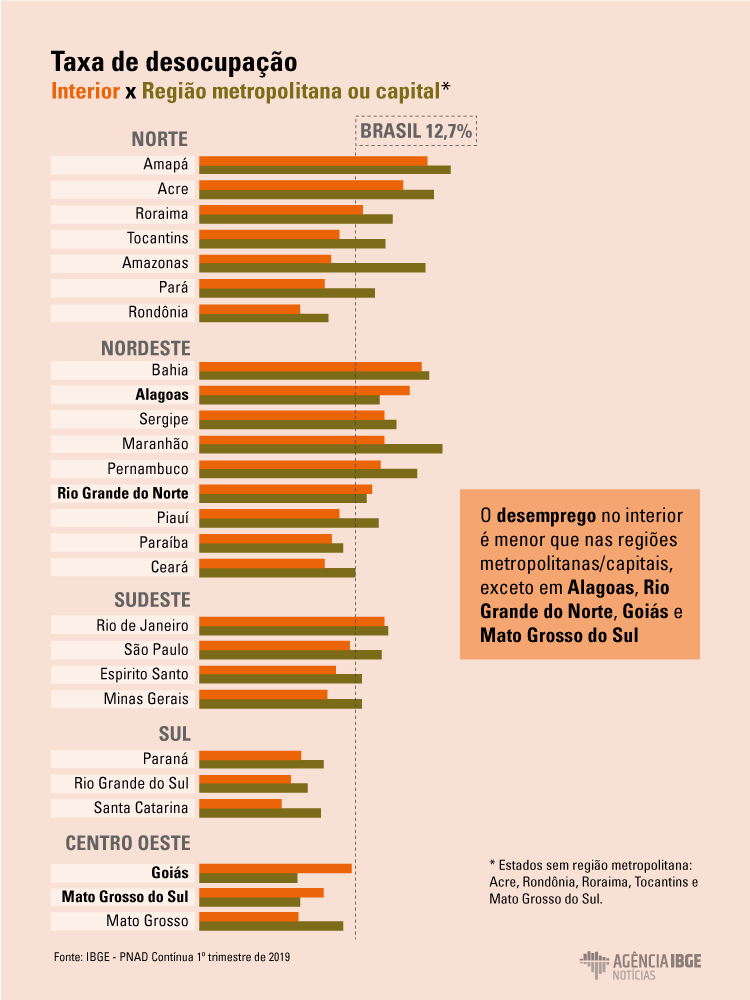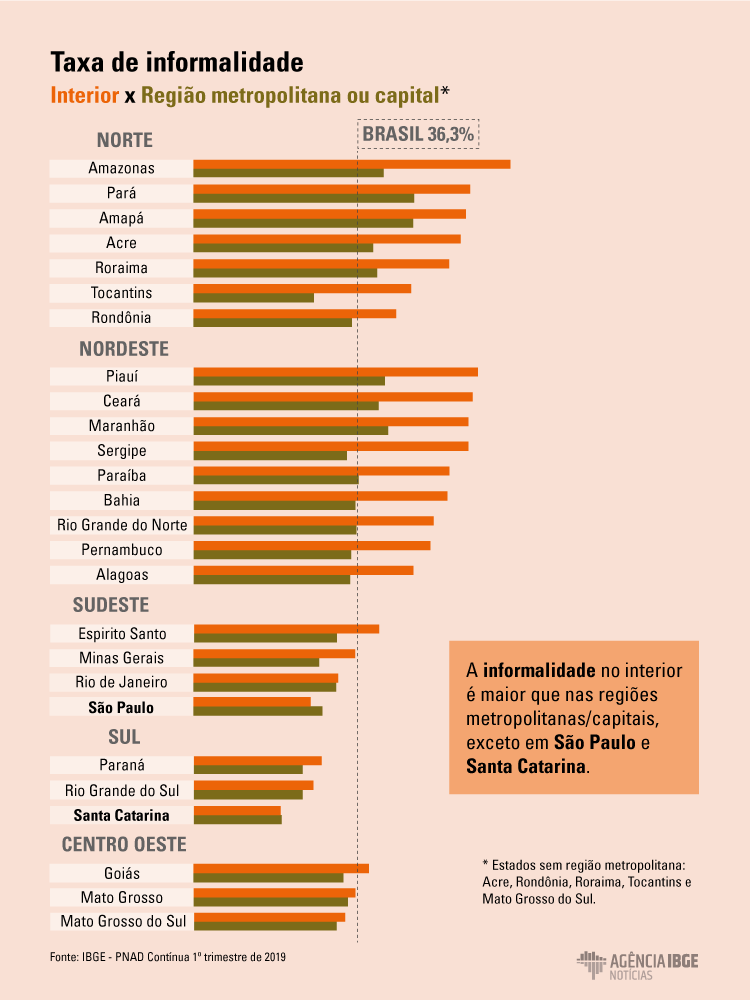PNAD Contínua
Survey unveils unprecedented picture of the labor market in the interior of Brazil
July 24, 2019 10h00 AM | Last Updated: July 26, 2019 12h59 PM
A survey based on the microdata of the Continuous National Household Sample Survey - Continuous PNAD unveiled an unprecedented picture of the labor market in the interior of Brazil. The information of the first quarter of 2019 shows that unemployment in the interior is smaller than in the metropolitan areas in 18 states. Among the five states without a metropolitan area, only the interior of Mato Grosso do Sul shows a bigger unemployment than in the capital.
To arrive at this territorial division, the interior was considered as all the municipalities of the state, except the metropolitan area, whenever it exists, and the capital. Compared with the unemployment rate of Brazil (12.7%), only ten areas in the interior registered a bigger unemployment than the national index.

Nevertheless, these results do not mean that the conditions in the labor market are better outside the major urban centers. On the contrary, 62.4% of the persons who work in the informal sector are in the interior, i.e., 20.8 million workers without a formal contract (private sector employees and domestic workers), without a CNPJ and not contributing to the official social security (employers and self-employed persons) or without any compensation (assisting family workers). In Brazil, 36.3% of the employed population fit in these informal conditions.
Informality in the interior is bigger than in the metropolitan areas, though this does not happen only in the states of São Paulo and Santa Catarina. Concerning the proportion of this population, Brazil has 13 states with at least half of their workers in the interior under informal condition. All these places are in the North and Northeast, and the interior of Amazonas has the biggest percentage, with 71.7% of informal persons. On the other hand, the interior of Santa Catarina has the smallest rate with 19.4% of its employed persons in the informal market.
Amazonas is also the state with the biggest difference of informal workers comparing the interior and the metropolitan area, followed by Sergipe, Ceará, Piauí, Bahia and Paraíba.

In addition to the unemployment and informality in the interior, the microdata of the Continuous PNAD show the average earnings of these places in the first quarter of the year. According to the survey, the monthly earnings of those employed in the interior amount to less than half of those earned by the workers of the capitals of eight states. The average in Brazil is R$2,291.
In Espírito Santo, for instance, while a worker in the interior earned R$1,725, a worker in the capital earned R$4,653, the highest difference found (R$2,928). Conversely, Rondônia reported the lowest difference (R$514), as the average earnings in the interior was R$1,736 against R$2,250 in Porto Velho.
The lowest monthly earnings were concentrated in the interior of the North and Northeast Regions, being the lowest one recorded in Amazonas, an average earnings of R$1,016. The regions in the interior with the highest earnings were in the states of São Paulo, Santa Catarina, Paraná, Rio Grande do Sul, Mato Grosso and Mato Grosso do Sul, all of them above R$2,000.

Interview
In an interview to the IBGE News Agency, the IBGE deputy director of Surveys and expert in labor an income, Cimar Azeredo, explains the concept of informality developed based on the Continuous PNAD. The researcher stresses the need to pinpoint the differences between the labor markets in the interior and in the central regions in order to plan public policies, as well as the relevance of this subject in the international agenda.

IBGE News Agency - What is the importance of this regional division on the informality of the labor market?
Cimar Azeredo – Mainly due to the economic downturn started in 2014/2015, Brazil lost nearly four million jobs with formal contract over the last five years. The side effect was the significant increase in the informality in all the regions of Brazil.
In the interior, where the informal labor relations are traditionally high, the increase was also significant. Mapping, knowing the peculiarities and characterizing the informality are key for the proposal and implementation of successful policies of employment generation in light of the heterogeneity of the labor market.
Agency - How informal labor is defined?
Azeredo - Informality is defined based on a proxy focused on the private sector. In the proposed indicator, informality comprises the employees who are not linked with the enterprises they work, as well as employers and self-employed workers whose enterprises are not registered in the CNPJ and who do not contribute to the Brazilian social security.
We included in this proxy indicator the domestic workers without a formal contract and assisting family workers, which are those persons who work to help a household resident or a relative, without earning any compensation.
It is important to remind that the construction of indicators of such nature takes into account the variables available in the surveys, like the Continuous PNAD in this case. "Desirable" measurements are not always "possible", and such limitation applies to every household survey in the world.
Agency - In terms of job quality, what are the differences between the interior and major urban centers?
Azeredo - It is important to highlight that the metropolitan areas concentrate workers of activity groups with more formal characteristics. It is because most industries are in the metropolitan areas, especially those that employ more persons.
Traditionally, industry is an activity group in which most of the employees have a formal contract and contribute to the social security. Although it has been a group that was mostly affected by the economic downturn, it remains one of the most formal groups.
In addition, the major industrial activities demand a number of services types along their production chains, including the specialized ones, with higher compensation, which fosters the generation of jobs and income in the tertiary sector. In turn, all this wage bill generates, through income effect, demand for consumer goods and services, stimulating new opportunities of employment, labor and income.
On the other hand, the agricultural sector, more present in the interior of Brazil, presents a bigger contingent of workers without a formal contract and who do not contribute to the social security.
Agency - What explains this difference of earnings?
Azeredo - It is related to the bigger informality in the interior. On average, an informal worker in the private sector earns slightly more than half of the earnings of the formal worker. In addition to the lack of links with the enterprise they work, the informal workers in the private sector do not have the same rights to the benefits and social protection of the formal workers.
Agency - From the point of view of social protection, what is the situation of the population in the informality?
Azeredo - Firstly, formal contracts provide employees in Brazil with a number of important rights, warranties and benefits that mainly generate a feeling of stability, which is key to the physical and mental health of the workers and their relatives.
Lay-offs, especially in the private sector, can come anytime, let alone in the Brazilian labor market, marked with a significant turnover. The possibility of lay-offs gets worse in periods of economic downturn, when formal works, as a general rule, will make a significant difference in the life of workers and their relatives.
Having access to the unemployment insurance, counting on the guarantee fund in case of lay-off, leaving work due to sickness absences or accidents without losing the compensation and the concrete possibility of counting on a retirement in the future are important differentials in the working relations.
Formal contracts frequently work as a way to access credit and the financial system, albeit the emergence of initiatives to supply credit and financial inclusion to workers with other types of employment relationships. For low-income workers, formal contracts reinforce the feeling of inclusion.
Informality is also harmful to the strengthening of the working relations and social dialogue as, for example, it weakens the organization and union representation.
Although we have highlighted the importance of the salaried worker with a formal contract, it is important to remind that this is not the only way of insertion and formalization in the labor market.
Agency - What motivated such detailed analysis of the informal labor market?
Azeredo - I have just highlighted how important it is a formal working relation and the differences of this type of relation in the life of the workers and their relatives. The International Labor Organization - ILO points out that informality, in all forms, causes multiple adverse consequences to workers, enterprises and society.
This relation is harmful to the workers due to the absence of benefits and significant reduction in the revenue of the government and in the productivity of the economy. Yet, informality also causes other distortions. It will affect the population as a whole, but it will be more perverse to the low-income population, women, black and brown population and those with less education.
When the United Nations - UN proposed the 2030 Agenda in 2015, it reinforced the message that "no one will be left behind". We have the Sustainable Development Goals - SDGs, which highlight the social, economic and environmental problems that devastate the planet. Goal 8, for example, pursues the sustained economic growth, inclusive and sustainable, full employment and decent work.
Informality is being ruled and the IBGE manages to adjust its main survey on the workforce in order to meet the international recommendations and produce more accurate indicators on informality.
Errata: the text confused informality rate with the distribution of informal workers between the interior and metropolises. Where it reads: "On the contrary, informality reaches 62.4% of the employed persons in the interior of the states"; it should read: "On the contrary, 62.4% of the persons who worked in informality are in the interior".


















